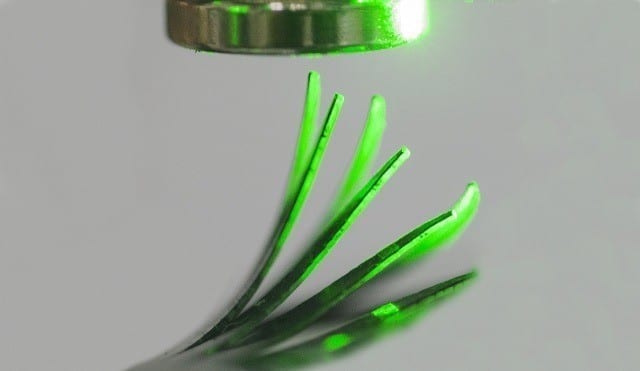
Elastomeric composites can flex, grip, release, or rotate when exposed to lasers, diffuse light or sunlight
Researchers at Tufts University School of Engineering have developed magnetic elastomeric composites that move in different ways when exposed to light, raising the possibility that these materials could enable a wide range of products that perform simple to complex movements, from tiny engines and valves to solar arrays that bend toward the sunlight. The research is described in an article published today in the Proceedings of the National Academy of Sciences.
In biology, there are many examples where light induces movement or change – think of flowers and leaves turning toward sunlight. The light actuated materials created in this study are based on the principle of the Curie temperature – the temperature above which certain materials will change their magnetic properties. By heating and cooling a magnetic material, one can turn its magnetism off and on. Biopolymers and elastomers doped with ferromagnetic CrO2 will heat up when exposed to laser or sunlight, temporarily losing their magnetic properties until they cool down again. The basic movements of the material, shaped into films, sponges, and hydrogels, are induced by nearby permanent or electromagnets and can exhibit as bending, twisting, and expansion.
“We could combine these simple movements into more complex motion, like crawling, walking, or swimming,” said Fiorenzo Omenetto, Ph.D., corresponding author of the study and the Frank C. Doble Professor of Engineering in the School of Engineering at Tufts. “And these movements can be triggered and controlled wirelessly, using light.”
Omenetto’s team demonstrated some of these complex movements by constructing soft grippers that capture and release objects in response to light illumination. “One of the advantages of these materials is that we can selectively activate portions of a structure and control them using localized or focused light,” said Meng Li, the first author of the paper, “And unlike other light actuated materials based on liquid crystals, these materials can be fashioned to move either toward, or away from the direction of the light. All of these features add up to the ability to make objects large and small with complex, coordinated movements.”
To demonstrate this versatility, the researchers constructed a simple “Curie engine”. A light actuated film was shaped into a ring and mounted on a needle post. Placed near a permanent magnet, when a laser was focused onto a fixed spot on the ring, it locally demagnetizes that portion of the ring, creating an unbalanced net force that causes the ring to turn. As it turns, the demagnetized spot regains its magnetization and a new spot is illuminated and demagnetized, causing the engine to continuously rotate.
Materials used to create the light actuated materials include polydimethylsoloxane (PDMS), which is a widely used transparent elastomer often shaped into flexible films, and silk fibroin, which is a versatile biocompatible material with excellent optical properties that can be shaped into a wide range of forms – from films to gels, threads, blocks and sponges.
“With additional material patterning, light patterning and magnetic field control, we could theoretically achieve even more complicated and fine-tuned movements, such as folding and unfolding, microfluidic valve switching, micro and nano-sized engines and more,” said Omenetto.
Learn more: Scientists develop new materials that move in response to light
The Latest on: Elastomeric composites
[google_news title=”” keyword=”elastomeric composites” num_posts=”10″ blurb_length=”0″ show_thumb=”left”]
via Google News
The Latest on: Elastomeric composites
- Stability of Meropenem in Polyvinyl Chloride Bags and an Elastomeric Infusion Deviceon April 30, 2024 at 5:00 pm
Purpose: The stability of meropenem in i.v. solutions stored in polyvinyl chloride (PVC) bags and an elastomeric infusion device at concentrations commonly used in home care was studied.
- Composite flooring makes for versatile trailerson April 29, 2024 at 5:00 pm
These demands are being solved by incorporating high strength composite materials. Many fleets are willing to bear a higher upfront cost for durable, lighter and versatile trailers since they provide ...
- Stability of Meropenem in Polyvinyl Chloride Bags and an Elastomeric Infusion Deviceon April 28, 2024 at 5:00 pm
Meropenem 4 mg/mL in NS was stable for at least seven days in PVC bags and elastomeric infusion containers when stored at 5° C. Meropenem 10 and 20 mg/mL in NS was stable for at least five days ...
- composite videoon September 7, 2023 at 5:00 pm
In the home computer market of the 1980s, there were several winners that are still household names four decades later: the Commodore 64, the Apple II and the Sinclair Spectrum, to name a few.
- Composite test methods (and specifications) for fiber-reinforced concrete structureson June 22, 2023 at 5:00 pm
Explore the cutting-edge composites industry, as experts delve into the materials, tooling, and manufacturing hurdles of meeting the demands of the promising advanced air mobility (AAM) market. Join ...
- How Much Does Composite Decking Cost?on April 20, 2023 at 6:59 am
Composite decking has a typical cost range of $3,600 to $7,800 and a national average cost of $5,450. There are several factors that affect composite decking cost, including the size, shape ...
- L. Bogue Sandberg, PEon May 7, 2021 at 10:43 pm
His research interests include the behavior of elastomeric sealants, behavior of structural glazing curtain wall systems, traditionally connected timber frames, molded wood strand composites, ...
- Chapter 15: Elastomeric Devices for Rotorcrafton March 5, 2018 at 9:37 pm
The material is typically bonded in thin layers alternately with equally thin layers of metal (or composite) to form a device that can serve both as a limited rotation bearing and/or as a source of ...
- Study on the Use of Elastomeric Respirators in Health Careon December 30, 2017 at 5:42 pm
The National Academies of Sciences, Engineering, and Medicine are private, nonprofit institutions that provide expert advice on some of the most pressing challenges facing the nation and world. Our ...
via Bing News









